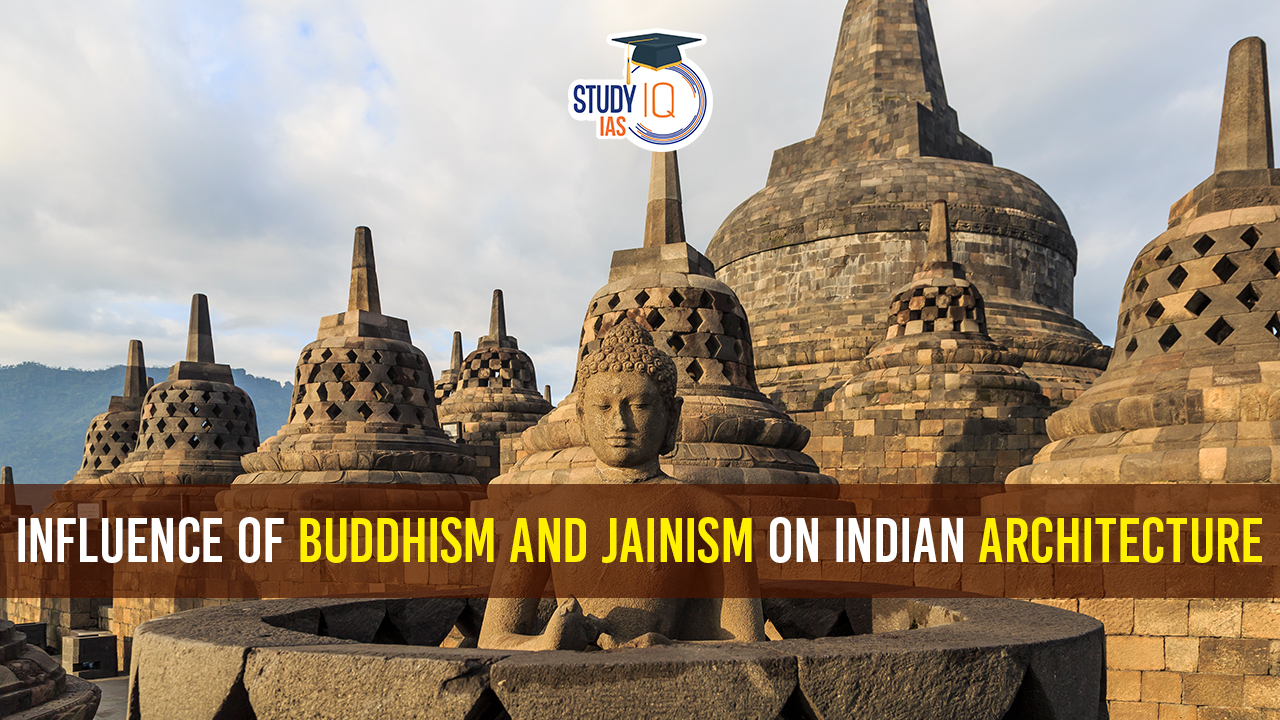Table of Contents
Buddhism and Jainism, two ancient religious traditions that originated in India, have had a profound influence on Indian architecture. Both religions emerged in the 6th century BCE as reactions against the ritualistic practices of Brahmanism (early Hinduism) and emphasized non-violence, asceticism, and the pursuit of spiritual enlightenment. The followers of Buddhism are called Buddhists, and those of Jainism are called Jains. The impact of these religions on Indian architecture is evident in the construction of stupas, viharas, and chaityas for Buddhists, as well as temples and monastic complexes for Jains.
We’re now on WhatsApp. Click to Join
Influence of Buddhism and Jainism on Indian Architecture
Buddhism profoundly shaped Indian architecture with iconic stupas like the Great Stupa at Sanchi, featuring hemispherical domes atop cylindrical bases adorned with harmikas and parasols. Viharas, communal living spaces for monks, and chaityas, prayer halls like those at Karla and Ajanta, showcase distinctive Buddhist designs. Rock-cut architecture, notably at Ajanta and Ellora, exemplifies Buddhism’s integration of religious art with natural landscapes. Conversely, Jainism influenced Indian architecture through ornate Jain temples like Dilwara in Mount Abu and Ranakpur, displaying intricate marble carvings. Jain distinctions, seen in temples like Vastupal-Tejpal in Khajuraho, emphasize Swetambara’s richness and Digambara’s austerity. Shared elements include non-violent motifs, contributing to the diverse regional styles across India.
Influence of Buddhism on Indian Architecture
Stupas
Design and Symbolism:
- Stupas are symbolic representations of the Buddhist cosmology and serve as focal points for worship. The circular shape symbolizes the cycle of birth, death, and rebirth (samsara).
- The hemispherical dome represents the world of humans, while the square base symbolizes the four cardinal directions.
Architectural Elements:
- The harmika, or square railing, atop the dome, represents the elevated state of enlightenment. It often contains the relics of the Buddha or other revered figures.
- The central mast with the chhatra (parasol) signifies the protection provided by the Buddha’s teachings.
Toranas (Gateways):
- Elaborate gateways or toranas surround stupas, featuring intricate carvings and sculptures that narrate episodes from the life of the Buddha and significant events in Buddhism.
- The toranas serve both a decorative and narrative purpose, guiding devotees through a visual journey of the Buddha’s life.
Sanchi Stupa:
- The Great Stupa at Sanchi, a UNESCO World Heritage site, is an exemplary representation of Buddhist stupa architecture. It was commissioned by Emperor Ashoka in the 3rd century BCE.
- Sanchi Stupa’s toranas are particularly famous for their detailed narrative reliefs.
Viharas and Chaityas
Viharas (Monasteries):
- Viharas were designed to accommodate Buddhist monks and nuns. These residential complexes typically consisted of individual cells for monks, common areas for meditation, and communal halls for religious activities.
- The architecture of viharas reflects the communal and ascetic lifestyle advocated by Buddhism.
Chaityas (Prayer Halls):
- Chaityas were dedicated prayer halls for congregational worship. The earliest chaityas were rock-cut caves, such as those at Karla and Ajanta.
- The interiors of chaityas often feature a stupa at the far end, surrounded by columns with intricate carvings depicting the Buddha and scenes from his life.
Rock-Cut Architecture:
- Buddhism played a pivotal role in the development of rock-cut architecture in India.
- Rock-cut caves, such as those at Ajanta and Ellora, showcase the integration of religious art with natural rock formations. The caves served as monastic retreats, prayer halls, and places for meditation.
- The Ajanta Caves, in particular, are known for their exquisite murals and sculptures illustrating the life of the Buddha and various Jataka tales.
Architectural Integration:
- The rock-cut architecture exemplifies the harmony between human craftsmanship and the natural environment, reflecting the Buddhist ideals of simplicity and non-attachment.
Legacy and Impact
- The architectural forms developed under Buddhism became influential not only in India but also in other parts of Asia where Buddhism spread, influencing the design of temples, stupas, and monastic complexes.
- The architectural principles established during this period continued to evolve, leading to the development of diverse styles across different regions and periods in the history of Indian architecture.
Influence of Jainism on Indian Architecture
Jain Temples
Ornate Architecture:
- Jain temples are renowned for their intricate and ornate architecture, featuring detailed carvings and sculptures in marble or stone.
- The emphasis on craftsmanship reflects the Jain principle of ahimsa (non-violence), with the avoidance of harming living beings extending to the construction process.
Prominent Examples:
- The Dilwara Temples in Mount Abu are exemplary Jain temples known for their exquisite marble carvings. The intricate detailing includes depictions of Jain Tirthankaras, celestial beings, and floral motifs.
- The Ranakpur Jain Temple, dedicated to Adinatha, showcases a mesmerizing array of marble pillars, each unique in design, contributing to the temple’s grandeur.
- The colossal Gommateshwara statue in Shravanabelagola, though not a temple, is a significant Jain monument. Carved from a single block of granite, it symbolizes asceticism and non-attachment.
Vastupal-Tejpal Temple Architecture
Khajuraho’s Architectural Marvel:
- The Vastupal-Tejpal Temple, located in the Khajuraho Group of Monuments, exemplifies the intricacy of Jain temple architecture.
- The temple, dedicated to Adinatha, features elaborate carvings illustrating Jain cosmology, divine beings, and scenes from the lives of Tirthankaras.
Craftsmanship and Detailing:
- Craftsmanship in the Vastupal-Tejpal Temple is of the highest order, with meticulous detailing in every aspect of the structure.
- The intricate carvings not only serve an aesthetic purpose but also convey philosophical and spiritual messages inherent in Jainism.
Manastambhas and Kirti Stambhas
Votive and Glory Pillars:
- Jain architecture extends beyond temples to include manastambhas and kirti stambhas, votive and glory pillars, respectively.
- Manastambhas are erected as symbols of devotion, adorned with intricate carvings, while kirti stambhas commemorate significant events, often featuring detailed sculptures and symbols.
Swetambara and Digambara Architectural Distinctions
Swetambara Temples:
- Swetambara, one of the two main Jain sects, influences temple architecture with a penchant for more elaborate decorations.
- Ornate carvings, vibrant paintings, and detailed sculptures characterize Swetambara temples, creating a visually rich and spiritually immersive environment.
Digambara Temples:
- Digambara temples, in contrast, may adopt a more austere architectural style. The emphasis is on simplicity, reflecting the Digambara philosophy of non-attachment to material possessions.
- While still adorned with symbolic elements, Digambara temples often convey a sense of restraint and minimalism.
Differences between Buddhist Architecture and Jain Architecture
| Basis of Comparison | Buddhist Architecture | Jain Architecture |
| Stupas, Pagoda, Monasteries | Observers of centuries, including Stupas, Pagodas, monasteries, and caves. | Temple builders extraordinary with religious shrines and pilgrimage sites. |
| Cave Architecture | Oldest form, exemplified by caves like Ajanta. | Rock-cut monasteries like Ellora Jain Cave Basadi, reflecting Jain heritage. |
| Stupas Structure | Dome-shaped monuments housing relics or commemorating events (e.g., Sanchi Stupa). | Jain Stupas for devotional purposes (e.g., Mathura Stupa). |
| Pagodas – Vimana Architecture | Multistory towers representing the universe’s components. | Vimana in Northern India, marking the position of the primary idol. |
| Chaitya and Vihara Structure | Chaityas as shrines with stupas for congregational service. Viharas for monks’ residence. | Chaitya structures common, Jain viharas simple with narrow cells for austerity. |
| Temple Architecture | Early temples carved from rocks. Mahabodhi Temple as an example. | Jain temples on raised platforms (Jagati or Vedi), surrounded by Prakara walls. |
| Harmika, Vedika, Torana | Components of Stupa architecture. Harmika is the stupa’s semicircular dome, Vedika is a stone barrier, and Torana is a ceremonial gateway. | Jain temples feature raised platforms, Prakara walls, and square plans with Tirthankara images. |
| South Indian Jain Architecture | Bettis with Gomata Raja images. Bastis are simple temples, e.g., Shravanabelagola’s Jaina architecture. | Bettis with Gomata Raja images. Bastis as simple Tirthankara temples, e.g., Shravanabelagola’s Jaina architecture. |
Influence of Buddhism and Jainism on Indian Architecture UPSC
Buddhism and Jainism, originating in 6th-century BCE India, significantly influenced Indian architecture. Buddhist architecture, epitomized by stupas, viharas, and rock-cut structures like Ajanta, reflects spiritual symbolism and harmonious integration with nature. Jain architecture, seen in ornate temples such as Dilwara and Vastupal-Tejpal, emphasizes craftsmanship and adherence to non-violence. Distinctive Jain features include Manastambhas, Kirti Stambhas, and Swetambara-Digambara distinctions. Despite differences, both traditions contributed to the diverse regional styles across India, shaping monumental structures that endure as cultural and spiritual legacies.


 Chakma and Hajong Communities: History, ...
Chakma and Hajong Communities: History, ...
 Sheesh Mahal in Delhi Restoration, Archi...
Sheesh Mahal in Delhi Restoration, Archi...
 Bonalu Festival 2025: Date, History, Rit...
Bonalu Festival 2025: Date, History, Rit...





















